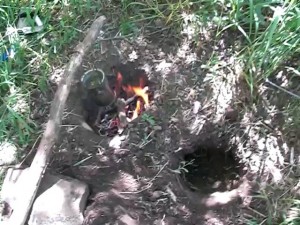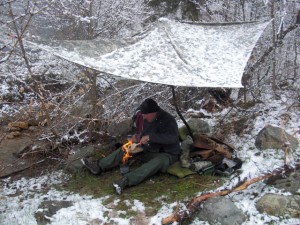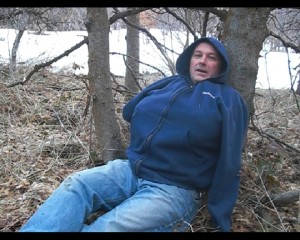When I think of survival, or even emergency preparedness, I tend to divide it up into categories. It's hard for us to do everything at once, and if we try we may become discouraged. The old saying still holds, “How do you eat an elephant? A bite at a time.” So lets break it all down and get organized, visualize a target with a bulls-eye at the center, and rings expanding out from that.
Step 1 - The Center or Bulls-Eye: EDC or as the survivalist world knows it Every Day Carry
Another blog on Every Day Carry will follow this one, with a post by Beau, detailing his experience with what he likes to carry, and his interviews with others about what they have with them. This is usually personal, and it should be, some items people don't want to disclose, and that's fine as well.
The only other thing I will say on this, leaving the rest to Beau, is I try to be a realist, a lot of what I see people saying is EDC is not; it is only EDC when out in the bush. I want to know what people carry ALWAYS, to me that's the true EDC. I always have a knife and a fire starter for example, that's my bare minimum.
Step 2 – First Ring: Personal Essentials – What most would call a Survival Kit
To survive all of us need the same things: Shelter, Fire, Water, Food, and Medical Care are some general categories. The amount of each we need varies according to our circumstances and our personal condition, but regardless, all of us will perish without these things. When I'm talking of the
First Ring – Personal Essentials I'm thinking of what an individual needs to live out a couple of days to perhaps a couple of weeks, truly surviving the ordeal, not necessarily in comfort.
Based on these factors we developed our
Real Survival Kit and the it's enhanced brother the
Off Road Survival Kit, both of these providing the tools needed to help a person get through difficult times. The kits contain items such as: Victorinox Swiss Army Knife, Doan Magnesium Fire Starter, 550 Parachute Cord, Compass, Whistle, First Aid Kit, Flashlight, Poncho, Space Blanket, Fish Hooks and leader, etc...
Step 3 – Second Ring: Personal Efficiency Survival Items – For Effective use of Time and Energy
Although our Wilderness Innovation survival kits, or kits you may have providing the same functionality, will generally get us through the tough spots; something of consideration, especially if the conditions are exceptionally rough or the amount of time we must stay out is extended, is conservation of energy and good use of time. To the onlooker, a person in a survival situation has nothing but time to kill, and that is most certainly
not true. In our modern society the amount of time we spend procuring food, shelter, fire and water, is relatively small. When conditions force us to survive, those things are now life and death matters, with not much leeway in there, 3 days max without water and depending on conditions, perhaps not even a day without fire or shelter. Time is critical to manage effectively.
Why the emphasis on energy conservation? The human body requires a lot of energy (calories obtained from food) just to stay operational. When a person doesn't know when he will eat again or in what quantity, it becomes imperative that all energy used is metered doing only that which is essential.
So in light of what we've just discussed what items would be key to saving energy and time?
Folding Saw – We may hack away with a folding knife or just try breaking branches for fire or shelter, but with a folding saw of 10 – 16 inches, we can do perhaps ten times the work for the same energy, and the time savings is proportional to that as well.
Tarp – A personal size tarp is light weight and very effective for creating all or part of a shelter. A lean-to of branches and boughs may take half a day to make, a debris hut may take a day to several days to make, a shelter formed with a tarp may be constructed in 15 to 30 minutes.
Fixed Blade Knife – A person may choose to insert a 4” to 6” heavy duty fixed blade knife here and forgo the Folding saw, placing it in the items of the Third Ring. A knife of this type is useful in chopping with a baton, carving, cutting, splitting and many other functions. A saw is certainly much more effective at cutting, but the knife is the only option for splitting.
Reserve Food Items – Carrying of extra dried or packaged food, will easily extend the time a person can hold out, as well as providing comfort and consolation in a difficult time. Ramen noodles are light, flavored, quick and easy to prepare, and they are convenient to combine with whatever a person may find locally. These should still be limited, light, and easy to prepare. Jerky, dried fruits and vegetables, rolled oats, nuts, etc.
Step 4 – Third Ring: Personal Comfort and Safety Items
At this point I would consider that we have broken somewhat from surviving to living, and this involves a good deal more in preparedness than simply survival items. This is where more thinking is involved and much more personalization, and customizing. In fact these items in the Third Ring will usually vary with the trip or adventure
Stove - This is a nice addition, it saves always having a fire, particularly if one is not needed for warmth, or is difficult to start or maintain due to current conditions. Food preparation time is greatly reduced, as is boiling water for purification.
Larger Tarp or bivy – For extra comfort a bivy or larger size tarp can offer more protection. I prefer the tarp because it can be configured so many different ways, where the bivy has a single method of deployment. Our new Survival Tarp Series are tabbed out in a way that they can be set up more than 12 ways.
Extra Food Items – Adding some MRE's or Freeze Dried meals can really take the edge off of a very tough situation. Include some food items you have tested and tried to give some welcome comfort while awaiting rescue.
Expanded First Aid – Include some personal items that you may need due to a condition. Triangle bandages, more gauze and cremes and lotions, perhaps a suture kit. Add plenty of extra pain relievers, etc.
Water Filtration – The addition of a quality water filter set up can save lots of fuel or time in the fire which makes moving about easier if you need to. Use the filter to stock up your water bottles
Ax – Finally as mentioned earlier an ax can really be a blessing. It can effectively split wood and even chop in a reasonable manner, you can use an ax to pound in stakes. It is unparalleled in prepping a pile of wood for the fire. You can get the job done and then relax a bit.
In closing, this list is not at all totally inclusive and should be in many cases customized for each person. More information and details will be discussed in future blogs.
Have a great day – Perry Peacock


 If you have read as many survival stories as I have, if you follow rescues in the paper, there are plenty of people who get out on snow machines, ATV's, bikes or hiking and either try to go too far or run into some difficulty. Then it's decision time, "do I still try to get home or do I button up and spend the night?"
If you have read as many survival stories as I have, if you follow rescues in the paper, there are plenty of people who get out on snow machines, ATV's, bikes or hiking and either try to go too far or run into some difficulty. Then it's decision time, "do I still try to get home or do I button up and spend the night?"

